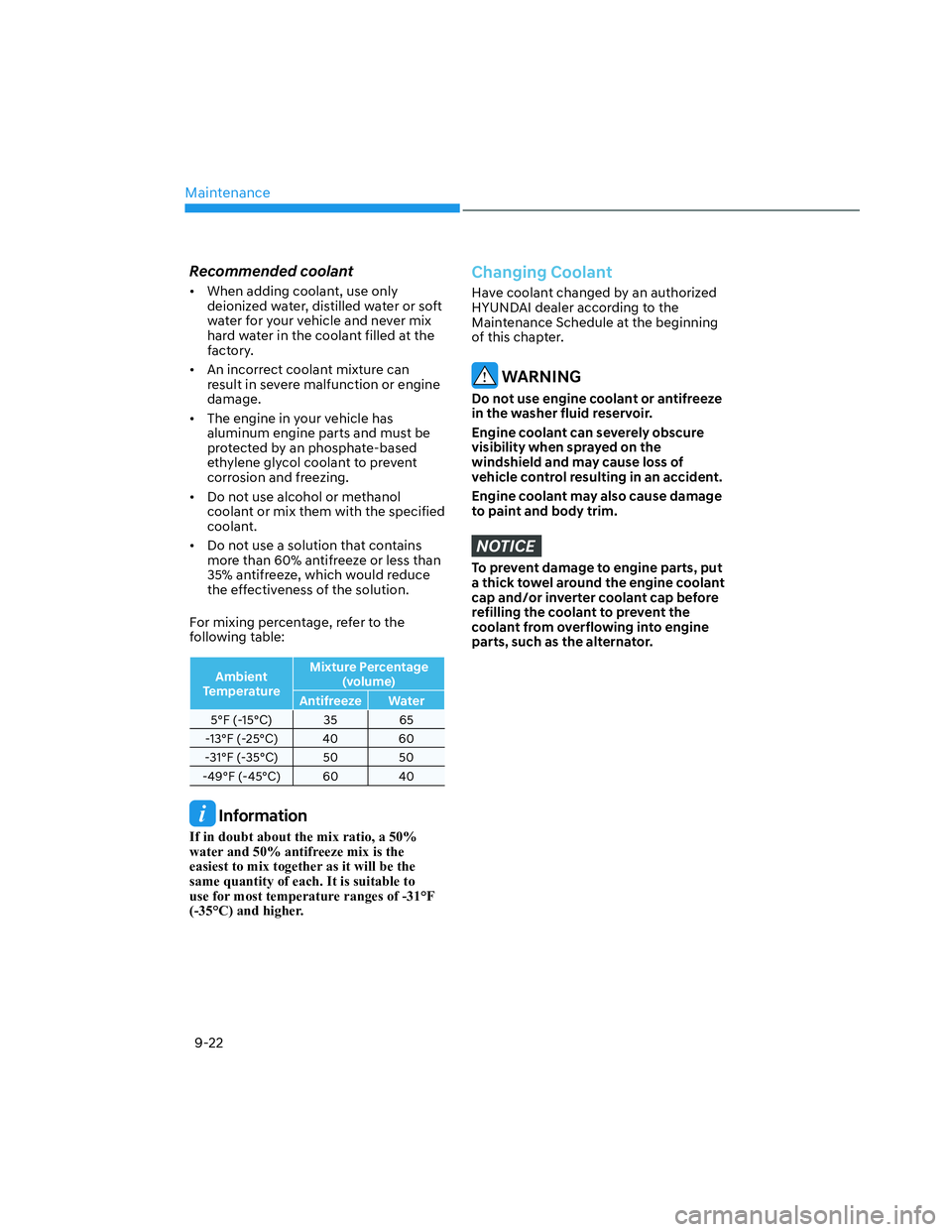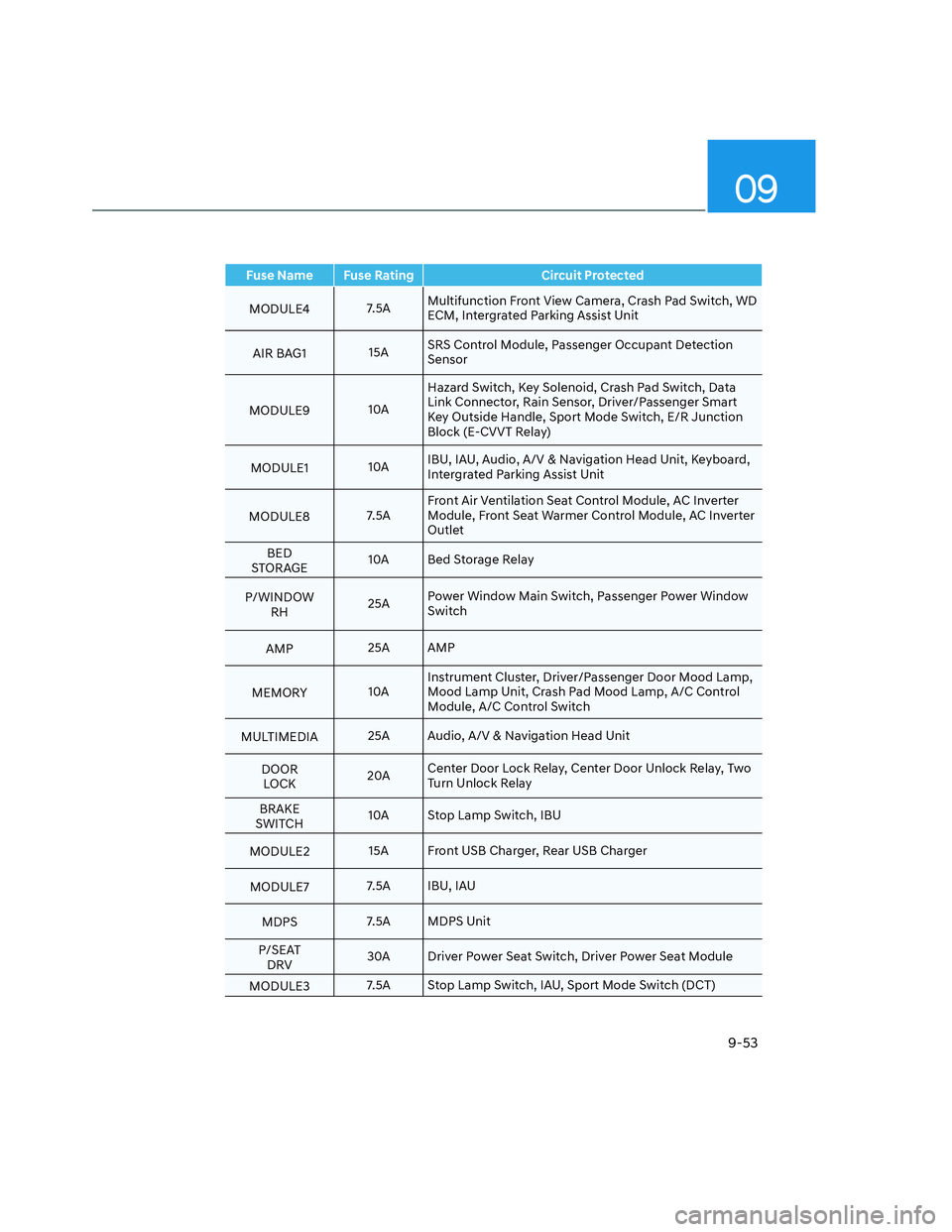2023 HYUNDAI SANTA CRUZ inverter
[x] Cancel search: inverterPage 82 of 598

Seats & Safety System
3-52
Main components of the Occupant
Classification System
• A detection device located within the
front passenger seat cushion.
• Electronic system to help determine
whether the passenger air bag
systems should be activated or
deactivated.
• An indicator light located on the
instrument panel which illuminates
the words “PASSENGER AIR BAG OFF”
indicating the front passenger air bag
system is deactivated.
• The instrument panel air bag indicator
light is interconnected with the OCS.
The OCS is designed to help detect
the presence of a properly-seated
front passenger and determine if the
passenger’s front air bag should be
enabled (may inflate) or not.
The purpose is to help reduce the risk
of injury or death from an inflating air
bag to certain front passenger seat
occupants, such as children, by requiring
the air bag to be automatically turned
OFF.
For example, if a child restraint of the
type specified in the regulations is on the
seat, the occupant classification sensor
can detect it and cause the air bag to
turn OFF.
Front passenger seat adult occupants
who are properly seated and wearing the
seat belt properly, should not cause the
passenger air bag to be automatically
turned OFF. For smaller adults it may turn
OFF, however, if the occupant does not
sit in the seat properly (for example, by
not sitting upright, by sitting on the edge
of the seat, or by otherwise being out of
position), this could cause the sensor to
turn the air bag OFF.You will find the “PASSENGER AIR BAG
OFF” indicator on the overhead console
panel. This system detects the conditions
1-4 in the following table and activates or
deactivates the front passenger air bag
based on these conditions.
Always be sure that you and all vehicle
occupants are seated properly and
wearing the seat belt properly for the
most effective protection by the air bag
and the seat belt.
The OCS may not function properly if the
passenger takes actions which can affect
the classification system. These include:
• Failing to sit in an upright position.
• Leaning against the door or center
console.
• Sitting towards the sides of the front
of the seat.
• Putting their legs on the dashboard or
resting them on other locations which
reduce the passenger weight on the
front seat.
• Wearing the seat belt improperly.
• Reclining the seatback.
• Wearing thick clothes like ski wear or
hip protection wear.
• Putting an additional thick cushion on
the seat.
• Putting electrical devices (for
example, notebook, satellite radio) on
the seat with inverter charging.
Page 85 of 598

03
3-55
OHI038158OHI038158
• NEVER lean on the door or center console or sit on
one side of the front passenger seat.
OJX1039069OJX1039069
• Do not sit on the passenger seat wearing heavily
padded clothes such as ski wear and hip protector.
OJX1039070OJX1039070
• Do not use car seat accessories such as thick blankets
and cushions which cover up the car seat surface.
OJX1039071OJX1039071
• Do not place electronic devices such as laptops, DVD
player, or conductive materials such as water bottles
on the passenger seat.
• Do not use electronic devices such as laptops and
satellite radios which use inverter chargers.
OJX1039072OJX1039072
• If large quantity of liquid has been spilled on the
passenger seat, the air bag warning light may
illuminate or malfunction.
Therefore, make sure the seat has been completely
dried before driving the vehicle.
• Do not place sharp objects on the front passenger seat. These may damage the
occupant detection system, if they puncture the seat cushion.
• Do not place any items under the front passenger seat.
• When changing or replacing the seat or seat cover, use original items only.
The OCS has been developed based on using original HYUNDAI car seats only.
Altering or changing the authentic parts may result in system malfunction and
increase risk of injury when in collision. Any of the above could interfere with the
proper operation of the OCS sensor thereby increasing the risk of an injury in an
accident.
Page 530 of 598

Maintenance
9-22
Recommended coolant
• When adding coolant, use only
deionized water, distilled water or soft
water for your vehicle and never mix
hard water in the coolant filled at the
factory.
• An incorrect coolant mixture can
result in severe malfunction or engine
damage.
• The engine in your vehicle has
aluminum engine parts and must be
protected by an phosphate-based
ethylene glycol coolant to prevent
corrosion and freezing.
• Do not use alcohol or methanol
coolant or mix them with the specified
coolant.
• Do not use a solution that contains
more than 60% antifreeze or less than
35% antifreeze, which would reduce
the effectiveness of the solution.
For mixing percentage, refer to the
following table:
Ambient
TemperatureMixture Percentage
(volume)
Antifreeze Water
5°F (-15°C) 35 65
-13°F (-25°C) 40 60
-31°F (-35°C) 50 50
-49°F (-45°C) 60 40
Information
If in doubt about the mix ratio, a 50%
water and 50% antifreeze mix is the
easiest to mix together as it will be the
same quantity of each. It is suitable to
use for most temperature ranges of -31°F
(-35°C) and higher.
Changing Coolant
Have coolant changed by an authorized
HYUNDAI dealer according to the
Maintenance Schedule at the beginning
of this chapter.
WARNING
Do not use engine coolant or antifreeze
in the washer fluid reservoir.
Engine coolant can severely obscure
visibility when sprayed on the
windshield and may cause loss of
vehicle control resulting in an accident.
Engine coolant may also cause damage
to paint and body trim.
NOTICE
To prevent damage to engine parts, put
a thick towel around the engine coolant
cap and/or inverter coolant cap before
refilling the coolant to prevent the
coolant from overflowing into engine
parts, such as the alternator.
Page 561 of 598

09
9-53
Fuse Name Fuse Rating Circuit Protected
MODULE47.5AMultifunction Front View Camera, Crash Pad Switch, WD
ECM, Intergrated Parking Assist Unit
AIR BAG115ASRS Control Module, Passenger Occupant Detection
Sensor
MODULE910AHazard Switch, Key Solenoid, Crash Pad Switch, Data
Link Connector, Rain Sensor, Driver/Passenger Smart
Key Outside Handle, Sport Mode Switch, E/R Junction
Block (E-CVVT Relay)
MODULE110AIBU, IAU, Audio, A/V & Navigation Head Unit, Keyboard,
Intergrated Parking Assist Unit
MODULE87.5AFront Air Ventilation Seat Control Module, AC Inverter
Module, Front Seat Warmer Control Module, AC Inverter
Outlet
BED
STORAGE10A Bed Storage Relay
P/WINDOW
RH25APower Window Main Switch, Passenger Power Window
Switch
AMP25A AMP
MEMORY10AInstrument Cluster, Driver/Passenger Door Mood Lamp,
Mood Lamp Unit, Crash Pad Mood Lamp, A/C Control
Module, A/C Control Switch
MULTIMEDIA25A Audio, A/V & Navigation Head Unit
DOOR
LOCK20ACenter Door Lock Relay, Center Door Unlock Relay, Two
Turn Unlock Relay
BRAKE
SWITCH10A Stop Lamp Switch, IBU
MODULE215A Front USB Charger, Rear USB Charger
MODULE77.5A IBU, IAU
MDPS7.5A MDPS Unit
P/SEAT
DRV30A Driver Power Seat Switch, Driver Power Seat Module
MODULE37.5A Stop Lamp Switch, IAU, Sport Mode Switch (DCT)
Page 563 of 598
![HYUNDAI SANTA CRUZ 2023 Owners Manual 09
9-55
Engine compartment fuse panel
Type Fuse NameFuse
RatingCircuit Protected
MULTI
FUSEMDPS80A MDPS Unit
COOLING FAN180A [G4KP] Cooling Fan Controller
COOLING FAN260A [G4KN] Cooling Fan Controlle HYUNDAI SANTA CRUZ 2023 Owners Manual 09
9-55
Engine compartment fuse panel
Type Fuse NameFuse
RatingCircuit Protected
MULTI
FUSEMDPS80A MDPS Unit
COOLING FAN180A [G4KP] Cooling Fan Controller
COOLING FAN260A [G4KN] Cooling Fan Controlle](/manual-img/35/56179/w960_56179-562.png)
09
9-55
Engine compartment fuse panel
Type Fuse NameFuse
RatingCircuit Protected
MULTI
FUSEMDPS80A MDPS Unit
COOLING FAN180A [G4KP] Cooling Fan Controller
COOLING FAN260A [G4KN] Cooling Fan Controller
B+260A ICU Junction Block (IPS7, IPS8, IPS9, IPS10, IPS11, IPS12)
B+360AICU Junction Block (Fuse - P/SEAT DRV, SAFETY P/
WINDOW RH, S/HEATER DRV/PASS, SUNROOF1, BED
STORAGE, Power Window Main Relay)
E-CVVT150A E/R Junction Block (E-CVVT Relay)
BLOWER40A E/R Junction Block (Blower Relay)
EPB140A ESC Module
REAR HEATED40A E/R Junction Block (Rear Heated Relay)
TRAILER 130A [G4KP] Trailer Connector
B+440AICU Junction Block (Fuse - DOOR LOCK, SAFETY P/
WINDOW LH, TAILGATE OPEN, AMP, IBU2, AIR BAG2,
CARGO LP, BRAKE SWITCH, MODULE9, Long Term
Load Latch Relay)
EPB260A ESC Module
FUEL PUMP20A E/R Junction Block (Fuel Pump Relay)
4WD20A AWD ECM
TRAILER 230A
[G4KN] Trailer Controller
AMS10A Battery Sensor
TRAILER 330A
[G4KN] Trailer Connector
ECU215A PCM/ECM
VACUUM PUMP120A
[G4KP] E/R Junction Block (Vacuum Pump Relay)
TCU115A [G4KN] PCM
ROOF LIGHT FRT15A Accessory Light Switch
E-CVVT220A [G4KP] ECM
HEATED MIRROR10AE/R Junction Block (Rear Heated Relay), Driver/
Passenger Power Outside Mirror
VACUUM PUMP210A [G4KP] ESC Module
TCU360A [G4KP] TCM
EOP60A [G4KP] Electronic Oil Pump
B+150A ICU Junction Block (IPS1, IPS3, IPS4, IPS5, IPS6,)
PTC HEATER50A E/R Junction Block (PTC Heater Relay)
INVERTER30A AC Inverter Module